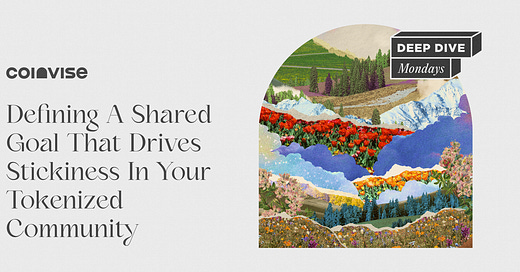Defining A Shared Goal That Drives Stickiness In Your Tokenized Community
Subscribe to our newsletter to receive twice a week directly in your inbox our best tips to help you build tokenized communities 🔥
If you’re not a subscriber yet, here’s what you missed:
Hey there - welcome back 👋
Today, I'll show you how to define a shared goal that drives stickiness.
Any community will fail if there are no compelling reasons for people to come together.
A shared goal enables members to finally accomplish something they can't achieve alone, drive stickiness and generate increasing network effects.
Unfortunately, too many community builders keep starting a community for its own sake, wanting to "start a DAO" or "build in Web3" — not looking to accomplish a broader goal. But they miss understanding one thing.
To succeed, your community needs a purpose beyond its existence.
So the first question when looking to launch a tokenized community should be:
"Why would people join, come back regularly, and contribute?"
There are many possible answers here:
Because they understand clearly the outcomes, they'll get.
Because they feel an emotional connection with your project.
Because they see how they can be valuable and want to help.
Because they identify with the problem.
Ultimately, these elements come down to a much simpler one: A shared goal.
So your very first mission when launching a tokenized community is to define your North Star and ensure all members go in the same direction.
To achieve this, you must follow three (simple) steps:
Step 1: Define With Your Members An Important Problem To Solve.
Far too many community builders set the goals for their community and then do everything they can to rally members around it.
It should be the other way around.
With your first community members, make a brainstorming session and define the most important problem you all have and want to solve.
That's the secret of all thriving tokenized communities.
They don't fight every day to get support and engagement because they focus on solving their members' problems. It's much easier to attract someone to help you achieve a goal if they're already trying to solve it themselves.
So organize a brainstorming session early on in the community journey and define:
The most pressing problem you all want to solve
The benefits of solving this problem
The obvious solution your community can come up with
Step 2: Then, Build A Story To Spread This Goal
Members need to believe and be part of something much bigger than them.
Anytime anyone asks you about the community goal, you should state the persuasive goal you've defined during the brainstorming session and use a story to illustrate it.
You can follow the "WWHS" framework to build a story that outline clearly the problem you're solving and why people should join and participate.
Following this framework, you have to create a story that says:
Here's who we are and where we're starting. [WHO]
Here's the problem—and here's why it matters. [WHAT]
Here's how we're going to solve this problem. [HOW]
Here's how your life will be different as a result. [SOLUTION]
Now, if you want to arouse emotion and that people make it their own, you need to pair the "WWHS" framework with the classic storyline of great stories:
Start with a personal story/problem [ATTENTION]
Continue with how things got worse [AGITATE]
Show a new perspective about what's intriguing [INTRIGUE]
Show the future benefits linked with the intrigue [FUTURE]
If you can master the art of creating great narratives, it will be easier for members to spread the goal and explain to newcomers why they should participate as well.
Step 3: Finally, Implement This Shared Goal In Daily Tasks.
Members need to feel they're actively working toward solving the problem daily.
That's why it's essential for the success of your community to give members control over future decisions and give them ownership over this shared goal.
And the easiest way to do so is to create an NFT Membership.
By requiring members to hold an NFT to access your community, you ensure every member owns a bite of the community and has in their wallet the virtual key that lets them vote on future strategic decisions.
With NFTs, everyone has the incentive to make it succeed. The upsides are shared, and the hard work members put into the community is reflected by the increasing value of their assets.
Implementing NFT Membership in your community creates a decentralized marketing team that accomplishes things you could have never done alone.
That's a wrap!
Coming back to our first question, if someone asks you, "Why would I want to join, come back regularly, and contribute to your community?" - You now have an answer.
Because you've followed all the steps to create a shared goal, members now:
Have a clear idea of the problem they will solve by joining you
Are part of a bigger project through a shared story
Have ownership over the community's future and the incentives to make it succeed.
And just like this, in one quick article, you learned how to define a shared goal that'll make members participate and stick around.
I hope these tips are helpful as you continue your community-building journey.
Chat next Thursday!
– Eliot Couvat (@CDTEliot)
Found this helpful?
Leave a comment and share this article with your friends 😉




